HIGHLIGHTS: SEPTEMBER 13, 2024
• U.S. dairy ingredients in Southeast Asia
• Colombian officials visit USDEC offices
• U.S. cheese supplier mission to Taiwan, Hong Kong
• Strengthening U.S. dairy ingredient B2B ties in Colombia
• Member opportunity: feed seminar in China
• IAG meeting set for Nov. 13
• Market Summary: EU milk prices lift
• Netherlands scraps environmental plan
• East, Gulf Coast port strike update
• Synlait refocuses Pōkeno facility
• Baladna begins work in Algeria
• Meiji reorganizes yogurt operations
• Company briefs: Tatua, Saputo, Yum China, Feihe, Hochdorf
Featured
U.S. dairy ingredient presence in Southeast Asia benefits from one-two-punch of USDEC seminar and Fi Asia booth
Continuing its annual practice established pre-pandemic, USDEC used the Food Ingredients Asia (Fi Asia) trade show as an opportune time to hold a seminar highlighting why regional buyers would benefit from working closely with suppliers of U.S. dairy protein, permeate, milk powder and other products in the U.S. dairy ingredient portfolio. On Sept. 2, prior to exhibiting at Fi Asia, USDEC held a one-day Dairy Supply and Innovation Seminar in Jakarta, attracting 103 Indonesian food and beverage industry professionals.
Seminar brings together suppliers and buyers
The one-day seminar helped elevate awareness of the United States’ large and diverse portfolio of dairy ingredients and provided ideas for innovative new products using U.S. dairy that align with regional tastes. The event brought together 22 representatives of USDEC member companies with the attendees. Six companies presented to the audience as part of the seminar program and were then joined by additional member representatives and their designated partners/distributors for the afternoon tabletop session and additional networking in conjunction with the event.
“The Indonesian customers were delighted to engage with such a strong contingent of USDEC member companies, strengthening business ties and reinforcing U.S. dairy’s commitment to the region,” said Kristi Saitama, USDEC vice president, Global Ingredients Marketing.
Before the member-buyer engagement, the seminar featured opening remarks from Arief Rashidi, country manager for Indonesia; Dali Ghazalay, regional director, USDEC Southeast Asia; and Lisa Ahramjian, USDA’s Agricultural Counselor for the U.S. Embassy in Indonesia. Presentations by USDEC Southeast Asia’s Martin Teo, senior director–food applications and innovation, and Anoo Pothen, consumer insights director, focused on innovation opportunities and consumer insights, respectively.
In addition, Monica Ganley, USDEC senior director, global trade analysis, gave a prerecorded market outlook, setting the stage for a discussion on demand and supply trends supporting U.S. dairy opportunities in the region led by USDEC Southeast Asia’s Marcus Ng, trade insights analyst. Peter Tirschwell, vice president, Journal of Commerce, S&P Global, also delivered a timely talk on navigating the current landscape for ocean container freight and implications for Southeast Asian importers.
The next ingredient seminar in the region will be Nov. 7, 2024, in Manila, Philippines, and USDEC will hold a similar pre-Fi Asia seminar again on Sept. 15, next year in Bangkok, Thailand.
“We welcome and encourage members to attend both these events showcasing why the United States is the ideal source of dairy ingredients delivering on Southeast Asian customer and consumer needs, now and in the future,” said Saitama.
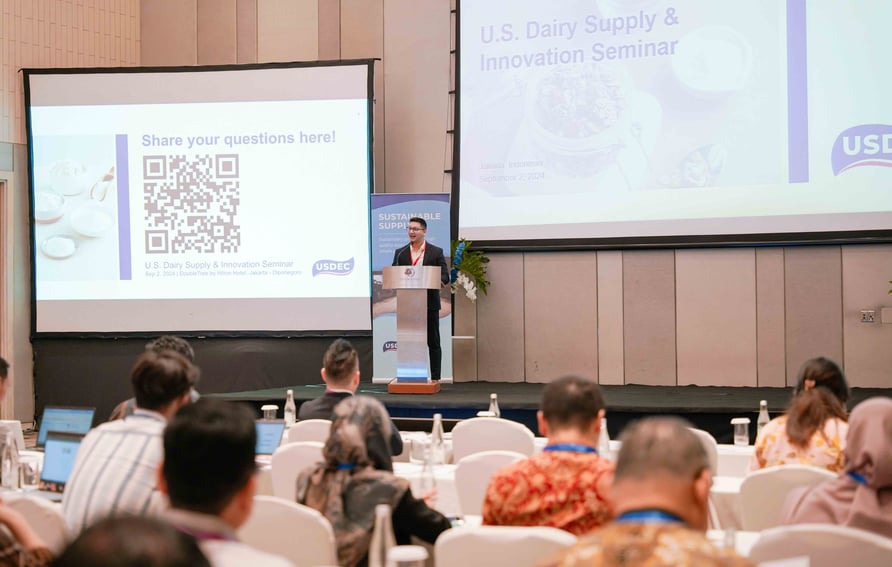
Arief Rashidi, USDEC’s country manager for Indonesia, provides opening remarks to the USDEC Dairy Supply and Innovation Seminar ahead of Fi Asia.
FI Asia reinforces U.S. dairy innovation potential
Following the seminar, USDEC staff engaged with Fi Asia attendees at the Jakarta International Expo. USDEC sought to reinforce many of the messages laid out at the seminar—specifically, how U.S. dairy ingredients can elevate every sip or bite of a drink or snack from a nutrition and functionality standpoint.
USDEC developed two protein-boosted products made with U.S. dairy ingredients for attendees to sample at Fi Asia and highlight the local-friendly food innovation opportunities those ingredients possess.
Protein meringue gems were inspired by Southeast Asia’s classic ice gem biscuits and introduced at the show to highlight opportunities to leverage U.S. dairy ingredients to offer consumers better-for-you options for their sweet cravings. The concept provides a burst of local flavor—either mango or lychee—that’s well-suited for an indulgent snack or as a protein-added topper for cakes and other baked goods.
Protein pandan coconut granola bars showcased another way food and beverage manufacturers can align new U.S. dairy ingredient-containing products with key consumption trends and deliver taste and nutrition for on-the-go eating occasions. This concept draws on the well-known blend of pandan and coconut with added protein from WPI and dairy protein crisps. It gave show attendees a chance to experience how a bar with added protein can meet local taste and texture preferences. It also leverages permeate to maintain taste, while reducing sodium content.
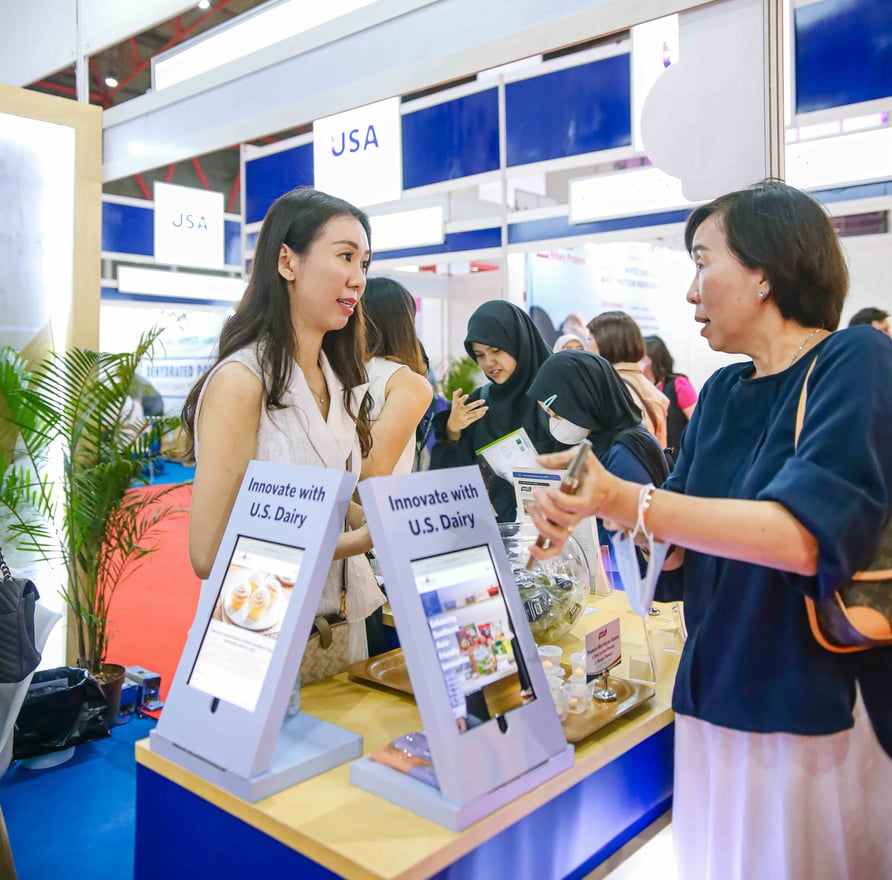
Food and beverage professionals stop at the USDEC booth at Fi Asia for information on U.S. dairy ingredients and how they can be used in local-friendly new product innovation.
Innovation webinar aims to inspire Southeast Asian food formulators
Days before Fi Asia and the Indonesia ingredient seminar, more than 130 current and potential U.S. dairy ingredient customers from across Southeast Asia tuned into the Aug. 28 webinar, “Innovate to Elevate: U.S. Dairy Ingredient Formulation Opportunities.” The webinar, broadcast from the U.S. Center for Dairy Excellence (U.S. CDE), introduced participants to the broad U.S. dairy ingredient portfolio (with a focus on SMP, dairy proteins and permeate), exploring features such as composition, functionality and performance in applications. An in-kitchen segment highlighted U.S. dairy ingredient bakery and snack prototypes.
The aim of the webinar was to spur Southeast Asian customers’ use of and innovation with U.S. dairy ingredients. Key speakers included Teo, Calista Foo, food technologist at the USDEC Southeast Asia office and Dali Ghazalay, regional director, USDEC Southeast Asia.
In addition to educating food and beverage formulators about dairy ingredients, the webinar also gathered information on those formulators’ needs and interests. A live online poll found wide-ranging interest in new dairy protein product innovation, with 25% specifically looking at beverage applications, 20% bakery, 16% sweet snacks and confectionery, 14% frozen desserts and ice cream, 13% savory snacks, and 12% ready-to-eat and quick meals.
In addition to being watched live, an archived version of the webinar is available for ongoing viewing.

Martin Teo and Calista Foo highlight bakery and snack prototypes made with U.S. dairy ingredients during the U.S. CDE’s Innovate to Elevate webinar.
Meeting with Colombian health and commerce officials accentuates the positive
Colombia offers a promising market for U.S. dairy exports, thanks to its expanding middle class, increased consumer spending, and a substantial population nearing 53 million. However, certain challenges remain.
On Wednesday, USDEC hosted officials from Colombia’s Ministry of Health, Ministry of Commerce, and the National Food and Drug Surveillance Institute (INVIMA) to explore collaborative efforts in advancing nutrition, food safety, and sustainability initiatives of mutual benefit.
Ongoing engagement
The meeting followed a nutrition workshop organized by USDA's Foreign Agricultural Service (FAS) in Bogotá last year and the recent U.S. dairy regulatory workshop hosted by USDEC’s Market Access and Regulatory Affairs (MARA) team in Colombia in July. This visit to the U.S. was part of an ongoing initiative to enhance Colombian officials' understanding of U.S. nutritional policies and regulations and to facilitate their engagement with Washington, D.C.-based food and beverage cooperators with commercial interests in Colombia.
The dialogue focused on addressing nutritional needs, opportunities for cooperation in nutritional research, promoting dairy consumption, sustainability and the application of U.S. dairy ingredients. The discussions come at a time when trade-restrictive actions and politically driven tensions between the two countries are high, typified by Colombia’s Subsidies and Countervailing Measures investigation into U.S. exports of milk powder.
In-depth discussions
USDEC representatives, including Jaime Castaneda and Tony Rice from the Trade Policy team and Jonathan Gardner and Oscar Ferrara from the MARA team, presented the roles of their respective departments. They discussed U.S. policies and regulatory actions aimed at promoting dairy consumption, advancing nutrition programs, facilitating trade, and eliminating trade barriers.
USDEC Senior Vice President of Global Ingredients Marketing Vikki Nicholson-West helped welcome the Colombian officials. She emphasized her team's eagerness to collaborate with them and their food manufacturers on utilizing U.S. dairy ingredients to enhance the functionality and nutritional profile of baked goods, confectionery items, soups, sauces, and a myriad of other food formulations.
“Dairy ingredients offer a wide world of innovation potential,” she noted, citing the example of increasing the protein content in foods and beverages through dairy proteins.
Emily Dolan, USDEC’s senior analyst for Sustainability and Multilateral Affairs, highlighted ongoing U.S. dairy initiatives aimed at boosting sustainability.
“The market increasingly expects sustainability, and we believe U.S. dairy's history and ambitious future goals demonstrate our commitment to meeting this expectation,” she said. By 2050, U.S. dairy aims to achieve greenhouse gas neutrality, optimize water usage, and enhance water quality through improved manure and nutrient management.
Supplier mission to Taiwan and Hong Kong educate cheese buyers on breadth and quality of U.S. portfolio
Seven U.S. cheese suppliers accompanied USDEC staff on the U.S. Cheese Mission to Taiwan and Hong Kong on Aug. 25-31. The mission sought to expand cheese exports from the United States, with a focus on increasing the penetration in the foodservice and retail sectors in both markets.
“Taiwan and Hong Kong are growing dairy markets, but the U.S. presence still lags significantly behind that of our Oceania competitors,” said Amy Foor, vice president, Global Foodservice Program. “This mission provided opportunities for U.S. cheese suppliers to learn more about the in-market opportunities for U.S. cheese, connect with pre-qualified purchasing decision makers from key cheese buying companies and promote the U.S. industry's broad cheese portfolio.”
Foor and Merle McNeil, USDEC senior vice president, Global Retail Programs, led the mission, assisted by representatives from the USDEC Taiwan and Hong Kong offices.
The agenda provided ample time for U.S. cheese suppliers to engage and network with representatives from 69 local companies (45 in Taiwan and 24 in Hong Kong). Activities in each market kicked off with presentations from the local Agricultural Trade Offices and USDEC staff on U.S. cheese opportunities, followed by retail tours. Supplier-buyer engagement included educational presentations on U.S. cheeses, supplier panel discussions, extensive one-on-one meetings between sellers and potential buyers, and networking receptions.
A selection of images from the mission follows below.

USDEC staff, U.S. suppliers and guests, including Jeremy Cornforth, deputy director, American Institute in Taiwan (brown suit, center), toast U.S. cheese at the USDEC reception in Taipei, Taiwan.
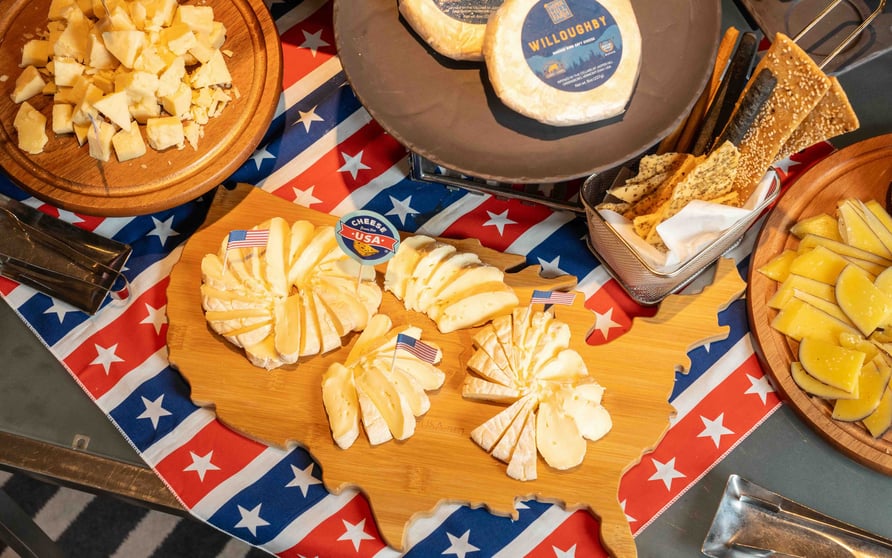
A portion of the U.S. cheese table from the Taiwan reception where buyers could sample a wide variety of U.S.-sourced cheeses.
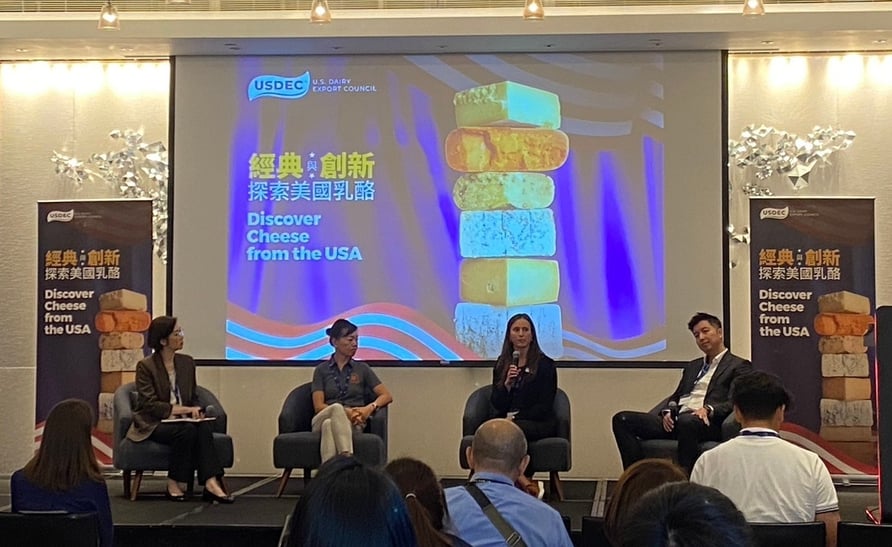
U.S. cheese supplier panel discussions in Taiwan and Hong Kong offered ample Q&A opportunities to the 69 buyer representatives who attended. Panelists included (left to right): Rosaline Chen, USDEC Taiwan, who served as moderator; Cynthia Liu, Orange Cheese Co.; Liz LeCaptain, Schreiber Foods; and Victor Kan, Dairy Farmers of America.

Six hours of one-on-one meetings between the U.S. suppliers on the mission and the cheese buyers provided valuable time to build new relationships and strengthen existing ones. Here, Schreiber Foods’ Liz LeCaptain talks about the company’s portfolio with a potential cheese buyer.
Expanding B2B ties in Colombia at Expo IAlimentos
Six USDEC members exhibited at the USDEC booth at this year’s Expo IAlimentos food show in Bogota, Colombia, which took place Sept. 4-5. Expo IAlimentos is the preeminent food ingredients show in Colombia, featuring both an exhibition floor and an educational program with expert speakers highlighting the latest trends and advances in food processing and nutrition.
USDEC, which co-sponsored the event, had a high-profile presence at both facets of the show. Despite a Colombian trucking strike that caused significant disruptions around the venue, members at the USDEC booth held 95 quality meetings (averaging more than 15 meetings per member) with prospective and existing customers, including major importers, distributors and food processors, such as Rocsa Colombia, Servicios Nutresa, DNA Distrinal, Comperpol SAS, Alpina and Congrupo.
USDEC also organized two dairy-focused sessions for the educational portion of the exposition. John Jairo Ortiz, a prominent Colombian food industry professional and USDEC’s domestic workshop trainer, outlined the functionality of high-quality dairy proteins for food and beverage innovation. Matt Pikosky, vice president of Nutrition Marketing and Affairs for National Dairy Council, highlighted the nutritional benefits of dairy proteins during a prerecorded virtual presentation. Jairo Ortiz’s presentation attracted nearly 450 viewers (combined in-person and online) and Pikosky drew 200 (online only).
“The turnout—both live and virtual—underscored the strong interest in using dairy ingredients to formulate new food and beverage products that respond to local consumer demands,” said Terri Rexroat, USDEC vice president, Global Ingredients Marketing. “It also highlighted USDEC’s significant engagement and impact at the event.”
Prior to the show, USDEC also arranged a market briefing for participating members and presented by USDEC South America lead Clarice Nagata and staff from the Colombia USDA Foreign Agriculture Service office, Rachel Nelson, Ana Salinas and Jose Quintero.
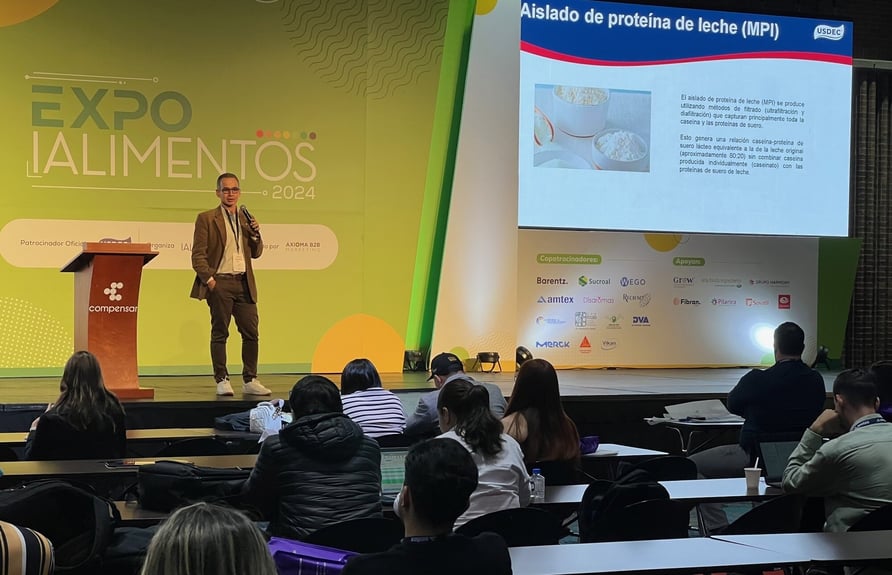
Colombian food industry professional and USDEC workshop trainer John Jairo Ortiz highlights U.S. dairy ingredient benefits at last week’s Expo IAlimentos.
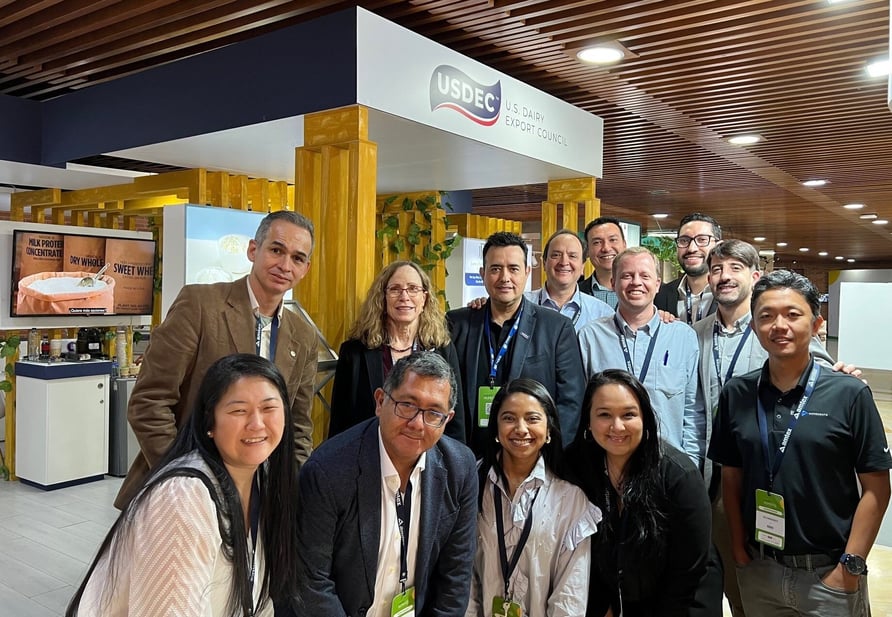
USDEC members and staff and speaker John Jairo Ortiz (standing left) at the USDEC booth at Expo IAlimentos.
Events
Member opportunity: feed seminar in China
The recovering Chinese pig market has prompted USDEC to organize its first feed seminar in China since before the pandemic. USDEC is looking to reengage with local producers to remind them of the benefits of adding permeate to piglet rations or increasing the permeate ratio.
The half-day seminar takes place Oct. 25 in Chengdu, China, in a hotel near the 13th Leman China Swine Conference & World Swine Industry Expo. The Leman conference runs Oct. 25-27 and is the largest pig-farming conference in the world, with this year’s event expected to attract more than 150,000 visitors.
USDEC has arranged a lineup of expert speakers to share the latest information on how permeate facilitates growth and healthier animals. Presenters include Dr. Sung Woo Kim, professor at North Carolina State University; Dr. Qingping Liu, International Ingredient Corp.; Dr. Guankun Wei, Lewin Hebei Nongbiao Biotech; and Dr. Daiwen Chen, professor at Sichuan Agricultural University.
The seminar will start at 9 a.m. and be followed by a luncheon at 12:30 p.m., where members, speakers and attendees will have opportunities for further discussions. To learn more about this event and see the full agenda, visit the seminar link in the Marketing Events section of the USDEC website. To participate or request an invitation for one of your current or potential customers, please contact Annie Bienvenue at abienvenue@usdec.org or Chang Su at changs@prcon.com.
Why you should attend the upcoming IAG meeting
The fall meeting of the USDEC Ingredient Advisory Group (IAG) is slated for Wednesday, Nov. 13, at the Royal Sonesta Chicago Downtown. Participation in the IAG and attendance at the meeting are some of the most effective ways for U.S. dairy ingredients suppliers to maximize their USDEC memberships. The meeting provides an opportunity for attendees to:
- Provide input and feedback on proposed 2025 ingredient marketing plans in Asia, Latin America, the Middle East and Africa to ensure alignment with members’ business needs and interests.
- Learn how USDEC ingredients marketing outreach efforts shine a positive spotlight on the advantages of buying and using U.S. dairy ingredients versus other origins and competitive proteins, which in turn, help enhance U.S. dairy export competitiveness.
- Hear from and engage with special guest Martin Teo, senior director–food applications and innovation, USDEC Southeast Asia, about U.S. dairy ingredient opportunities in the region.
The meeting runs from 8:00 a.m.-4:00 p.m. Members have until Oct. 22 to book a room at the reduced USDEC group rate. Please contact Suzanna Stohr at sstohr@usdec.org for the booking link or with questions about the meeting.
Market Summary
EU milk prices strengthen
EU farmgate milk prices are on the rise as commodity prices continue to heat up. Average farmgate prices passed year-ago levels in June for the first time this year, then ticked higher in July and are estimated up again in August. While still short of the record highs of 2022, prices are well above the five-year average, and the price gap with 2023 is growing.
Strong EU commodity prices are supporting the raw milk price increase, butter in particular. Average EU butter prices have been rising since February, recently surging to record highs. While WMP, SMP and whey powder haven’t had a seven-month growth streak like butter, they have all seen prices increase steadily since mid-July. European cheese prices are strengthening as well, although more slowly and unevenly.
Improving economic growth (while EU GDP growth in the first half was modest, it was the highest it’s been since the third quarter of 2022) and shrinking inflation in the EU have helped lift domestic dairy demand. Improved demand coupled with reports of tightening EU milk supplies have contributed to the commodity price momentum.
Netherlands steps back from nitrogen plan—for now
Last week, the Netherlands coalition government scrapped the country’s National Rural Area Programme (NPLG). The NPLG set was established by the previous administration as a roadmap to help the country meet European Union environmental goals, including lower nitrogen emissions. The plan included policies that would lead to significant reductions in the nation’s dairy cow herd.
Dutch elections in late 2023, influenced heavily by farmers protesting increasingly tighter environmental regulations, ushered in the new coalition government. Leaders believe they have a mandate to address policies that farmers view as overly restrictive and a threat to their livelihoods.
Over the past five years (2018-2023), Dutch milk output has been virtually flat, with productivity gains offsetting declining herd size. Through the first six months of 2024, year-over-year Dutch milk deliveries were down 1.4%.
It’s too early to determine how scrapping the NPLG might influence Dutch dairy sector expansion. States in the Netherlands reportedly had been making progress toward NPLG goals, and farmers had formulated plans knowing the government had budgeted €500-million per year (about US$550 million) to those who made nature-friendly investments, including toward nitrogen reduction.
The Netherlands is still bound by European requirements related to nitrogen, climate and water even without the NPLG. The coalition government said it plans to maintain existing environmental goals, but it has yet to announce a plan detailing its strategy to do so. The only certainty is that Dutch farmers are left with more uncertainty as they plot their business strategies. (Euronews, 9/6/24; Pig Progress, 9/5/24)
Supply Chain
East, Gulf Coast port strike concern grows
The threat of a port strike on the East and Gulf Coasts continues to ramp up. Last week, port employers of the United States Maritime Alliance (USMX) said that, along with the International Longshoremen’s Association (ILA), it had filed a “notice to mediation agencies” with the Federal Mediation & Conciliation Service (FMCS). Earlier this month, the ILA warned the USMX that the union is prepared to strike if a new labor deal is not signed before their current master contract expires on Sept. 30 (see Global Dairy eBrief, 8/16/24).
The intention of the filing was to inform the FMCS of a dispute between the parties; it does not represent an agreement for mediation. While the filing said “USMX continues to meet with its members in preparation for the resumption of negotiations, and it remains committed to working with the ILA leadership on a new agreement.” Meanwhile, ILA officials convened for a wage scale meeting last week to review contract demands. At those meetings, ILA laid out a strike mobilization plan and Union President Harold Daggett said there will “most definitely” be a strike if an agreement isn’t reached by Sept. 30.
Shipping industry officials and business groups representing major importers are expressing increasing concerns about the potential strike, with some—including the Retail Industry Leaders Association—calling on the Biden administration to broker a deal. The fall retail shopping season is already seeing an earlier-than-usual surge of cargo, which is causing additional strain on ocean shipping channels already disrupted by the ongoing attacks on commercial vessels in the Red Sea. Industry insiders say the walkout would result in significant disruptions across global supply chains. (Supply Chain Dive, 9/6/24; The Loadstar, 9/2/24; Wall Street Journal, 8/30/24)
Company News
Synlait Pōkeno facility to focus on advanced nutrition products
Following a strategic review of its North Island assets, New Zealand-based dairy processor Synlait Milk said it will refocus operations in its manufacturing facility in Pōkeno exclusively on producing advanced nutrition products that do not require raw milk. The company said the review, which was part of Synlait’s business recovery plan, found that switching between processing dairy and non-dairy hybrid nutrition products hinders operational efficiency in the Pōkeno plant and that transportation and other manufacturing costs make it financially unviable for Synlait to keep processing milk there. Synlait said its Dunsandel plant will remain the hub of the business for dairy operations. (Company reports)
Baladna begins work on powdered milk farm in Algeria
Four months after the Algerian Ministry of Agriculture and Rural Development and Qatar-based dairy company Baladna agreed to build an integrated dairy to produce milk powder in Algeria, the first phase of the project began with the drilling of exploratory wells throughout the allocated land needed to feed the dairy herd. The drilling work of the $3.5-billion venture aims to study the nature of the groundwater to ensure the optimal design of the wells. The farm will reportedly be the largest integrated vertical farm in the world, with more than 270,000 head of cows producing about 1.7 billion liters of milk annually. The three-phased project includes an arable farming operation first, then four dairy farms, followed by a state-of-the-art factory to produce powdered milk. Baladna said earlier this year that the project is expected to meet 50% of Algeria’s need for powdered milk. (USDEC MENA Office; Zawya, 9/4/24)
Meiji reorganizes yogurt operations
Meiji Holdings is reorganizing its yogurt production sites in Japan to cut costs and improve efficiency. The company will close three factories in the Miyagi, Saitama and Kanagawa prefectures and build a new ¥40-million (about US$282 million) plant in Kanagawa. The Miyagi plant will close in late 2025; the Saitama and Kanagawa facilities will shut down in spring and summer 2027. Meiji expects to open the new facility in March 2027. (Jiji Press, 9/7/24)
Mergers, acquisitions and joint ventures
General Mills is selling its North American yogurt business to French dairy processors Lactalis and Sodiaal in cash deals valued in total at $2.1 billion. Lactalis is acquiring the U.S. business, including manufacturing facilities in Tennessee and Michigan. Sodiaal is acquiring the Canadian operations, including a plant in Quebec. General Mills will provide further details in its upcoming first-quarter results announcement. … Australia’s Beston Global Food Co. said that Japan’s Megmilk Snow Brand has made an offer for its cheese and lactoferrin production business in Jervois, South Australia. … New Jersey-based Tropical Cheese Industries is reportedly working with investment bank Rothschild and Co. to explore a sale of the Hispanic dairy products maker. Sources say a deal for the family-owned company could be worth more than $500 million. … AS Equity Partners signed a definitive agreement with Hochdorf Holding Ltd. to acquire Switzerland-based milk processor Hochdorf Swiss Nutrition Ltd. Shareholders will vote on approval of the deal next week. (Wall Street Journal, 9/12/24; Just Food, 9/12/24; Reuters, 9/3/24; Company reports)
Company briefs
New Zealand’s Tatua Co-operative Dairy is reportedly undertaking an NZ$85 million project (about US$52 million) to significantly expand cream products production at its North Island headquarters. … Chinese infant formula maker Feihe and Dutch dairy giant FrieslandCampina signed the cooperation agreement in Beijing. The two companies will work together to develop and market “nutrition solutions” with a focus on brain health for consumers across all age groups. … It took about three months for Yum China to open the first 100 Pizza Hut WOW outlets in China. Pizza Hut WOW is an altered version of a standard Pizza Hut location focusing on price and efficiency. Most of the menu items at WOW stores align with original Pizza Hut stores but are tailored for single and more price-sensitive consumers. Yum China plans to expand the number of WOW outlets to 200 by the end of this year. … Canadian dairy company Saputo announced several leadership appointments in conjunction with Carl Colizza’s taking over the role of president and CEO on Aug. 9. The appointments, which are effective immediately, include Frank Guido as COO, Leanne Cutts to the newly created position of chief commercial officer, Dominick Bombino as president and COO, Dairy Division (USA), and Steve Douglas as president and COO, Dairy Division (UK). … After failing to find a buyer for its King Island Dairy facility, Saputo Dairy Australia said it will close the plant and retire the brand in 2025. The plant, which produces hand-made specialty cheeses, is nearly 100 years old. … In a move the company said was a “matter of efficiency,” France-based Danone transferred the production of its Tetra Pak-packaged YoPro drinkable high-protein yogurts to its plant in Bucharest, Romania. Those drinks are being manufactured for the central and eastern European markets, while the rest of the YoPro product line is still being made at facilities in Poland and Spain. (USDEC China office; Company reports; New Zealand Herald, 9/9/24; Just Food, 9/9/24)
In Case You Missed It...
U.S. Dairy Exporter Blog
Market analysis, research and news subscribe hereUSDEC Twitter feed
Follow us here.